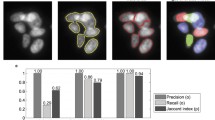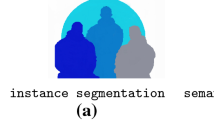Abstract
We have performed segmentation procedures on a large number of images from two mammalian cell lines that were seeded at low density, in order to study trends in the segmentation results and make predictions about cellular features that affect segmentation accuracy. By comparing segmentation results from approximately 40000 cells, we find a linear relationship between the highest segmentation accuracy seen for a given cell and the fraction of pixels in the neighborhood of the edge of that cell. This fraction of pixels is at greatest risk for error when cells are segmented. We call the ratio of the size of this pixel fraction to the size of the cell the extended edge neighborhood and this metric can predict segmentation accuracy of any isolated cell.
This contribution of NIST, an agency of the U.S. government, is not subject to copyright.
Access this chapter
Tax calculation will be finalised at checkout
Purchases are for personal use only
Preview
Unable to display preview. Download preview PDF.
Similar content being viewed by others
References
Plant, A.L., Elliott, J.T., Tona, A., McDaniel, D., Langenbach, K.J.: Tools for Quantitative and Validated Measurements of Cells. In: Taylor, L., Giuliano, K., Haskins, J. (eds.) High Content Screening: A Powerful Approach to Systems Cell Biology and Drug Discovery. Humana Press, Totowa (2006)
Elliott, J.T., Tona, A., Plant, A.L.: Comparison of reagents for shape analysis of fixed cells by automated fluorescence microscopy. Cytometry 52A, 90–100 (2003)
Elliott, J.T., Woodward, J.T., Langenbach, K.J., Tona, A., Jones, P.L., Plant, A.L.: Vascular smooth muscle cell response on thin films of collagen. Matrix Biol. 24(7), 489–502 (2005)
Zhou, X., Wong, S.T.C.: High content cellular imaging for drug development. IEEE Signal Processing Magazine 23(2), 170–174 (2006)
Coelho, L.P., Shariff, A., Murphy, R.F.: Nuclear Segmentation in Microscope Cell Images: A Hand-Segmented Dataset and Comparison of Algorithms. In: ISBI (2009)
Cardinale, J., Rauch, A., Barral, Y., Szkely, G., Sbalzarini, I.F.: Bayesian image analysis with on-line confidence estimates and its application to microtubule tracking. In: IEEE International Symposium of Biomedical Imaging, pp. 1091–1094 (June 2009)
Dima, A., Elliott, J.T., Filliben, J.J., Halter, M., Peskin, A., Bernal, J., Stotrup, B.L., Kociolek, M., Brady, M.C., Tang, H.C., Plant, A.L.: Comparison of segmentation algorithms for flourescence microscopy images of cells. Cytometry Part A (submitted)
Langenbach, K.J., Elliott, J.T., Tona, A., Plant, A.L.: Evaluating the correlation between fibroblast morphology and promoter activity on thin films of extracellular matrix proteins. BMC-Biotechnology 6(1), 14 (2006)
Chalfoun, J., Dima, A., Peskin, A.P., Elliot, J., Filliben, J.J.: A Human Inspired Local Ratio-Based Algorithm for Edge Detection in Fluorescent Cell Images. In: 6th International Symposium on Visual Computing 2010 (2010)
Peskin, A.P., Kafadar, K., Dima, A.: A Quality Pre-Processor for Biological Cells. In: 2009 International Conference Visual Computing (2009)
Hastie, T., Tibshirani, R., Friedman, J.H.: The Elements of Statistical Learning: Data Mining, Inference, And Prediction. Springer, New York (2001)
Peskin, A.P., Kafadar, K., Santos, A.M., Haemer, G.G.: Robust Volume Calculations of Tumors of Various Sizes. In: 2009 International Conference on Image Processing. Computer Vision, and Pattern Recognition (2009)
Rand, W.M.: Objective criteria for the evaluation of clustering methods. Journal of the American Statistical Association 66(336), 846–850 (1971)
Author information
Authors and Affiliations
Editor information
Editors and Affiliations
Rights and permissions
Copyright information
© 2010 Springer-Verlag Berlin Heidelberg
About this paper
Cite this paper
Peskin, A.P., Dima, A.A., Chalfoun, J., Elliott, J.T. (2010). Predicting Segmentation Accuracy for Biological Cell Images. In: Bebis, G., et al. Advances in Visual Computing. ISVC 2010. Lecture Notes in Computer Science, vol 6453. Springer, Berlin, Heidelberg. https://doi.org/10.1007/978-3-642-17289-2_53
Download citation
DOI: https://doi.org/10.1007/978-3-642-17289-2_53
Publisher Name: Springer, Berlin, Heidelberg
Print ISBN: 978-3-642-17288-5
Online ISBN: 978-3-642-17289-2
eBook Packages: Computer ScienceComputer Science (R0)




